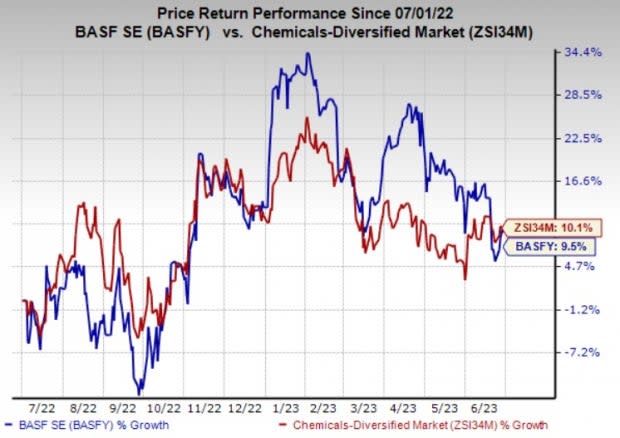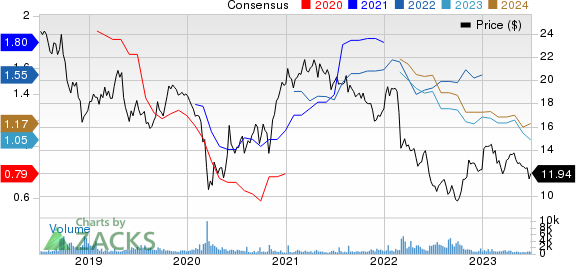BASF (BASFY) and Yara Collaborate on Low-Carbon Ammonia Plant
BASF SE BASFY and Yara Clean Ammonia have joined forces to undertake a significant initiative in the quest for sustainability. The two companies are working on a joint study to construct a world-scale low-carbon blue ammonia production facility in the U.S. Gulf Coast region.
With a projected capacity of 1.2-1.4 million tons per annum, this facility aims to meet the rising global demand for low-carbon ammonia. The collaboration between BASF and Yara Clean Ammonia builds upon their successful history of working together.
One of the key objectives of the facility is to capture around 95% of the carbon dioxide (CO2) generated during the production process and store it underground. By achieving this feat, Yara can offer its customers clean ammonia with a significantly reduced carbon footprint. Additionally, for BASF, the new plant would serve as backward integration, meeting the company's demand for low-carbon ammonia and further reducing the carbon footprint of its ammonia-based products.
BASF emphasized the project's importance in driving the sustainable transformation of the chemical industry. Leveraging BASF's existing Verbund sites in the region, which boast integrated material flows and advanced infrastructure, the integration of the new world-scale ammonia facility holds the potential to greatly improve the carbon footprint of BASF's operations and the industries it serves.
BASF and Yara have a long-standing partnership and successfully operate a joint world-scale ammonia plant at BASF's site in Freeport, TX. The companies anticipate completing the feasibility study for the low-carbon blue ammonia production facility by the end of 2023.
Blue ammonia shares identical characteristics with conventionally produced ammonia. However, its production process captures CO2, preventing its release into the atmosphere. As a result, blue ammonia plays a significant role in transitioning to alternative, less carbon-intensive products. This aligns with BASF's commitment to reducing its absolute CO2 emissions by 25% by 2030 compared to 2018 and achieving net-zero CO2 emissions by 2050.
The collaboration between BASF and Yara Clean Ammonia marks a significant milestone in the pursuit of sustainability within the chemical industry. By investing in this low-carbon ammonia facility, the companies are not only meeting the growing demand for environmentally friendly products but also spearheading the transformation toward a greener future.
BASF’s shares have gained 9.5% in the past year against the 10.1% rise of its industry. The Zacks Consensus Estimate for the company’s current-year earnings has been revised 12.5% downward in the past 60 days.

Image Source: Zacks Investment Research
BASF’s CO2 emissions for 2022 came in at 18.4 million metric tons, below 20.2 million metric tons it recorded in 2021. Softer demand due to the economic slowdown, higher natural gas prices in Europe due to Russia-Ukraine war and pandemic-led lockdowns in China led to a significant reduction in production volume. This, along with the temporary shutdown of emission-intensive plants, resulted in reduced emissions in 2022. A spike in natural gas prices led to the reduction or temporary shutdown of production in ammonia plants.
The company expects CO2 emissions between 18.1 million metric tons and 19.1 million metric tons in 2023. It sees a modest rise in production and moderately higher capacity utilization at emissions-intensive plants to contribute to additional emissions this year. The ammonia plants in Europe are likely to witness increased capacity utilization on a year-over-year basis. BASF expects to offset this with actions to cut emissions, boost energy efficiency and shift to electricity from renewable energies.
BASF SE Price and Consensus

BASF SE price-consensus-chart | BASF SE Quote
Zacks Rank & Key Picks
BASF currently has a Zacks Rank #4 (Sell).
Better-ranked stocks worth a look in the basic materials space include L.B. Foster Company FSTR, Koppers Holdings Inc. KOP and Linde plc LIN.
L.B. Foster currently carries a Zacks Rank #1 (Strong Buy). The Zacks Consensus Estimate for FSTR's current-year earnings has been stable over the past 60 days. You can see the complete list of today’s Zacks #1 Rank stocks here.
L.B. Foster’s earnings beat the Zacks Consensus Estimate in each of the last four quarters. It has a trailing four-quarter earnings surprise of roughly 140.5%, on average. FSTR shares have gained around 11% in a year.
Koppers currently carries a Zacks Rank #2 (Buy). The Zacks Consensus Estimate for KOP’s current-year earnings has been stable over the past 60 days.
The consensus estimate for current-year earnings for KOP is currently pegged at $4.40, reflecting an expected year-over-year growth of 6.3%. Koppers’ shares have rallied roughly 48% in the past year.
Linde currently carries a Zacks Rank #2. The Zacks Consensus Estimate for LIN’s current-year earnings has been revised 1% upward in the past 60 days.
Linde beat the Zacks Consensus Estimate in each of the last four quarters. It delivered a trailing four-quarter earnings surprise of 6.9% on average. LIN shares have popped roughly 33% in the past year.
Disclaimer: This article has been written with the assistance of Generative AI. However, the author has reviewed, revised, supplemented, and rewritten parts of this content to ensure its originality and the precision of the incorporated information.
Want the latest recommendations from Zacks Investment Research? Today, you can download 7 Best Stocks for the Next 30 Days. Click to get this free report
BASF SE (BASFY) : Free Stock Analysis Report
L.B. Foster Company (FSTR) : Free Stock Analysis Report
Koppers Holdings Inc. (KOP) : Free Stock Analysis Report
Linde PLC (LIN) : Free Stock Analysis Report
